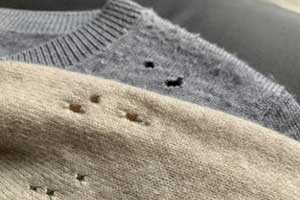
If you notice that your clothes are mysteriously deteriorating whenever you store them away for a long time, or you notice small worm-like creatures in your drawers and closets, then you might have clothes moths. Clothes moth larvae are extremely destructive and don’t discriminate between expensive and inexpensive fabrics.
Learn more about clothes moths, how to identify them, and what you can do to prevent them from destroying your clothes.
What Are Clothes Moths?
Clothes moths are small, usually grayish or an ivory colored moths that are frequently found in dark places, such as closets. In the United States, clothes moths usually come in two types: webbing clothes moths and casemaking clothes moths. These moths lay eggs on fabrics or in cracks and crevices near the natural fiber materials for their larvae to consume. The adults do not eat anything and live just long enough to breed.
Casemaking clothes moths are named because their larvae make a small tube around their body and carry it around as they feed. Webbing clothes moth larvae make tunnels and web mats. Both types of moths feed on the same food and prefer to live in the same conditions.
How Can You Tell If You Have Clothes Moths?
One sign of a clothes moth infestation is if you find damage to your clothing. Clothes moth larvae also like to destroy cloth around seams and edges, making them look tattered. If you have furs, then you will notice that they seem to shed more than usual and even look mangy. Affected clothing will also have crusty patches.
You may actually see the larvae crawling on your clothes or wiggling around on the floor if you knock them off the clothing. However, you are unlikely to see the adults as they do not like light. The only time you might see an adult is when you first open your closet door or dresser drawer and see them scatter into the dark areas.
Where Do Clothes Moths Live?
Closets and drawers full of seasonal clothing that sits unused for months make ideal breeding locations for clothes moths. You can also find moths in the attic, especially if you also store fabric items up there. They especially like fabrics that are folded or piled up. Clothes moths can be transported to your home through secondhand clothing or can fly right through damaged screens.
What Materials Do Clothes Moths Eat?
Clothes moth larvae prefer to eat natural fibers, most particularly animal products such as wool, fur, feathers, hair, and silk. However, they will also eat through cotton and sometimes eat dust and animal dander. Though they don’t eat synthetic fibers, they will chew through those fibers to reach natural fibers nearby.
How Can Clothes Moths Be Prevented?
If your infestation is mild, or you don’t have one yet, then you can take steps to protect your clothing and prevent an infestation. Here are a few steps you can take to prevent your clothing from damage.
- Discard severely damaged items
- Clean your closet regularly
- Set traps to keep adult moths from breeding
- Seal up your clothes immediately after laundering
- Shake out your clothing outdoors to dislodge larvae
Some experts also suggest putting your difficult-to-wash fabrics in the freezer to kill off any eggs or larvae but your normal kitchen freezer does not get cold enough to kill the eggs.. Also, don’t rely on cedar linings or mothballs to solve your problem. Cedar is effective but has limitations and must be refreshed. Mothballs work if you follow the manufacturer’s instructions but can be toxic to people and pets as well.
If you take steps to protect your clothing and deny the moth larvae their food, then chances are that your moth problem will stay minimal. However, if you find that you have a large, reoccurring moth problem, then call for extra help.
A-Alert Exterminating Service Inc will come out and evaluate your moth problem and find the solution that works best for you. Contact us to make an appointment.


